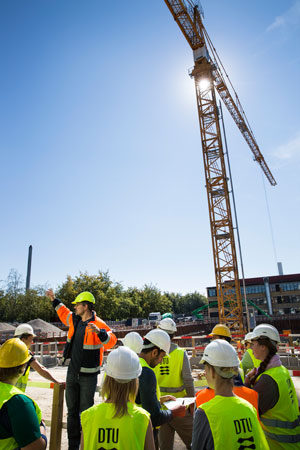Construction sites at Lyngby Campus form part of the civil engineering study programme.
On a sunny, late summer afternoon, 44 BEng students wearing safety shoes, reflective vests and helmets congregate in the 12-metre deep hole on the Life Science & Bioengineering construction site in Building 201-205.
The ‘excursion’ is a part of their course ‘Design and Construction of Buildings’, which is offered in the fourth semester as part of the Building and Civil Engineering study programme.

External Associate Professor Esper Christophersen, leads the students safely down to the construction site. Now in his ninth year as lecturer at DTU, Esper holds the position of Section Director for Construction & Refurbishment, Construction East at MT Højgaard—the contractor for the basic structure for Building 202—a project for which Esper is responsible.
“I always take my students on a tour of one of MT Højgaard’s construction sites. This time we can dispense with the bus fare and simply walk to the site. It’s important to visit a real building site because reality always differs from the drawing board,” comments Esper Christophersen on his reasons for exploiting DTU’s construction sites in a teaching context.
With obvious enthusiasm, he throws out his arms and ask the students to survey the building site:
“Study the site and note how many processes we have going on at the same time —excavation work, structural concrete work and installation. The more you can plan and optimize the on-site construction processes, the more profitable your business.”

A view of the area emphasizes the Section Director’s point, with excavation and casting work being carried out and cranes moving concrete elements about—their operators quite oblivious to the fact that they are being watched by the next generation of civil engineers. Esper shares several more points with his students and it is very much a case of paying attention, as they will subsequently have to use their knowledge to solve building planning and pricing assignments.
The course, which extends over seven teaching days and six project days, concludes with an exam. The basic structure is scheduled for completion in 2015.
Article in DTUavisen no. 8, October 2014.